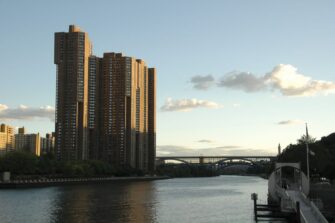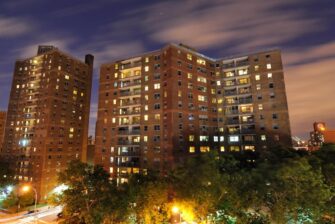Co-op City Personal Injury Attorney

Co-op City (short for Cooperative City), is a true city within a city: It has 35 high-rises and more than 200 townhouses, plus shopping centers, schools, houses of worship and even its own security force. Located in the Baychester section of the Bronx, it is the largest cooperative housing development in the world.
Table of Contents
- 1
- 2
- 3 Need a Personal Injury Attorney in Co-op City?
- 4 Our Trial Attorneys Focus on Mesothelioma Claims
- 5 Award-Winning Lawyers Serving Co-op City
- 6 Our Top-Rated Law Firm Gets Results
- 7 Our Legal Services
- 8 Key Features of the Area
- 9 Brief History of Co-op City
- 10 Location
- 11 Interesting Facts About Co-op City
- 12 Directions to Belluck & Fox from Co-op City
Need a Personal Injury Attorney in Co-op City?
With more than 20 years of experience, the top-ranked personal injury lawyers at Belluck & Fox have earned a national reputation for obtaining maximum compensation for those who have been unjustly harmed. With extensive resources and a strong litigation team, our law firm has what it takes to win against large corporations and deep-pocketed insurers.
Schedule a free consultation today to discuss your personal injury claim.
Our Trial Attorneys Focus on Mesothelioma Claims
Mesothelioma is a deadly cancer that is caused by exposure to asbestos. For many years, companies used asbestos materials in factories, manufacturing plants, commercial and residential buildings. Although these companies knew about the serious health risks related to asbestos exposure, they failed to warn workers and consumers. Decades later, those who were exposed continue to be diagnosed with life-threatening diseases such as mesothelioma and lung cancer.
Our New York City mesothelioma cancer law firm has a strong track record of securing maximum compensation for mesothelioma patients and their families. We are aggressive in our pursuit of payment for past and future medical expenses, lost wages, and pain and suffering. Our driving motivation is justice for our clients.
Award-Winning Lawyers Serving Co-op City
Our Bronx personal injury attorneys have earned recognition from many professional legal publications and review services, including:
- The National Law Journal
- Martindale Hubbell
- Best Lawyers
- Super Lawyers
- Avvo
 Our Top-Rated Law Firm Gets Results
Our Top-Rated Law Firm Gets Results
Our seasoned New York City personal injury lawyers have extensive experience obtaining maximum compensation for our deserving clients. In fact, our respected trial attorneys are proud to have won more than $1 billion in verdicts and settlements for the individuals and families we represent. Read more about our case results.
Our Legal Services
Our skilled attorneys handle a variety of complex injury cases involving:
- Defective products
- Dangerous pharmaceuticals
- Asbestos diseases
- Workplace accidents
- Slip and fall accidents
- Construction accidents
- Nursing home abuse
- Car accidents
- Truck accidents
- Motorcycle wrecks
- Dog bites
- Wrongful death
Key Features of the Area
Built on the grounds the amusement park Freedomland U.S.A. after it closed in the 1960s, Co-op City encompasses more than 320 acres. With 15,372 apartments, it is New York City’s largest apartment complex.
In the City that Never Sleeps, Co-op City also is unusual for being relatively isolated. The subway does not reach here, although city buses do. This area also is surrounded by the New England Thruway, the Hutchinson River and the Hutchinson River Parkway.
Co-op City’s units are limited-equity co-ops, meaning the residents own the buildings collectively but cannot profit from resale of their units. Urban developer Robert Moses, nonprofit housing developer Abraham E. Kazan, and then-Governor Nelson Rockefeller are credited with founding Co-op City. Moses helped smooth the way for the project’s approval; Kazan was the leader of the United Housing Foundation, which sponsored and built the project; and Rockefeller provided state loans for assistance.
 Financial issues, including cost overruns related to shoddy construction, caused Co-op City problems, particularly in the 1970s, but it has rebounded. It is often called a “city within a city” because it has its own ZIP code, public library, power plant, police force and weekly newspaper (The Co-op City Times), in addition to public parks, parking garages, schools, an extension campus of the College of New Rochelle, houses of worship and shopping centers.
Financial issues, including cost overruns related to shoddy construction, caused Co-op City problems, particularly in the 1970s, but it has rebounded. It is often called a “city within a city” because it has its own ZIP code, public library, power plant, police force and weekly newspaper (The Co-op City Times), in addition to public parks, parking garages, schools, an extension campus of the College of New Rochelle, houses of worship and shopping centers.
Brief History of Co-op City
1964: Freedomland U.S.A., a Bronx amusement park conceived by one of the original planners and managers of Disneyland, declares bankruptcy, citing competition from the 1964 New York World’s Fair. The park is torn down.
1965: The United Housing Foundation sponsors the project that will become Co-op City on the old Freedomland site. Architect Herman J. Jessor designs the project. The complex’s corporation changes its name to RiverBay at Co-op City.
1972: Construction is completed.
1975: Due to mismanagement and other issues, the complex defaults on a mortgage loan from New York State’s Housing Finance Agency. Refinancing in the 2000s helps RiverBay satisfy its $57 million mortgage obligation; construction repairs earn RiverBay credit toward eliminating the rest of its debt.
2000s: The complex undergoes a wide-scale $240 million renovation project that replaces piping and garbage compactors, switches to energy-efficient lighting and water-conserving technologies, performs exterior repairs, upgrades the power plant, and replaces 130,000 windows, 4,000 terrace doors and 179 elevators.
2007: Iris Herskowitz Baez, a former president of RiverBay’s board of directors, and a former painting contractor pleaded guilty to a kickback scheme where Baez steered $3.5 million in subsidized painting contracts for Co-op City apartments to the contractor’s company.
2010: According to the Census, about 44,000 people live in Co-op City.
Location
Shaped somewhat like a kidney, Co-op City is tucked in the Baychester section of the Bronx. The Hutchinson River abuts its east side; the Hutchinson River Parkway borders the south. The curve of the New England Thruway provides its northern and western boundaries.
Interesting Facts About Co-op City
- As of January 2010, prospective residents of Co-op City must not have a felony conviction; must not belong to the Section 8 program; must not have another primary residence; and must have a credit score of at least 650 for a one-bedroom unit and 700 for units with two or three bedrooms. Applicants also must be subject to a home visit during the application process.
- The Co-op City Department of Public Safety employs more than 100 officers and 10 civilian employees.
- At 338 feet tall, some of Co-op City’s high-rises were the tallest buildings in the Bronx in 1972 until the 400-foot-tall Tracey Towers opened in 1973.
Directions to Belluck & Fox from Co-op City
Belluck & Fox’s Manhattan office is located in Midtown at 546 Fifth Ave., 5th Floor, New York NY 10036. From Co-op City, get onto the New England Thruway (I-95) south. Following signs for the Robert F. Kennedy Bridge, aka the Triborough Bridge, keep left to continue onto I-278 West to the bridge and Manhattan. Use the left two lanes to exit onto the FDR Drive South. Take Exit 10 for East 49th Street. Turn left onto Fifth Avenue.
Our office also is accessible via some public transportation. Take the Bx5 bus from Bartow Ave./Co-op City Blvd. to Bruckner Blvd./Westchester Ave., then take a downtown 6 subway train from the Pelham Bay Park station to Grand Central/42nd Street.
Other Areas We Serve In Bronx, NY:
- Bedford Park
- Belmont Arthur Avenue
- Castle Hill
- Fieldston
- Kingsbridge
- Morris Park
- Riverdale
 Our Top-Rated Law Firm Gets Results
Our Top-Rated Law Firm Gets Results